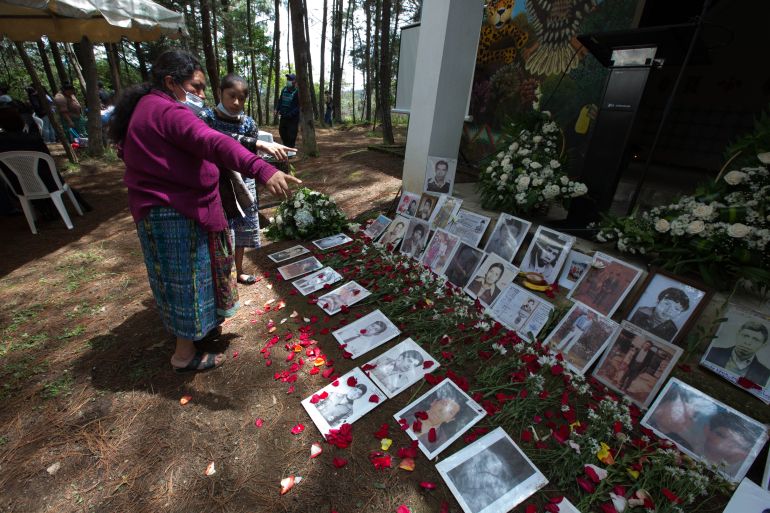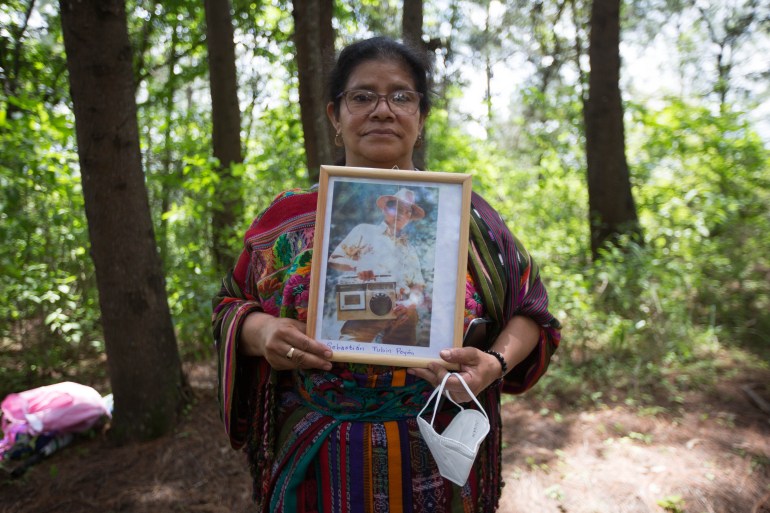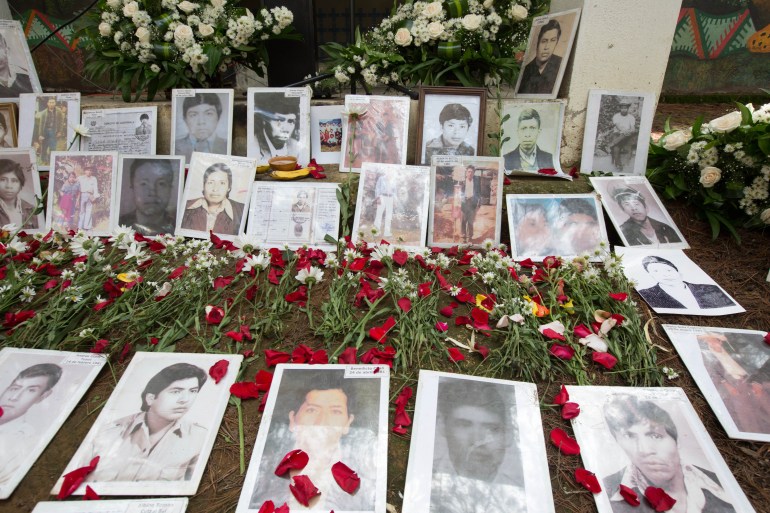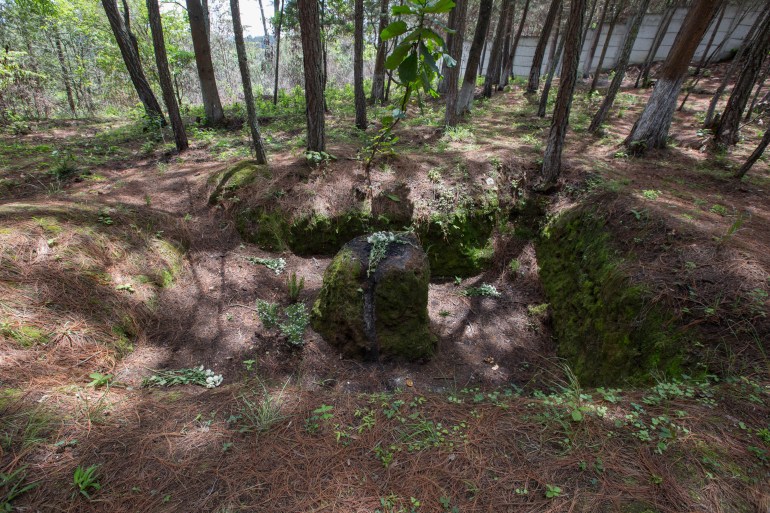Lessons from Guatemala’s painstaking search for the disappeared
Search for and identification of remains of civil war disappeared provides hope for families, but challenges persist.

San Juan Comalapa, Guatemala – Victoria Tubin was 10 years old when her father was disappeared by the Guatemalan military.
It was September 1981 – the height of the country’s 36-year armed conflict – and Sebastian Tubin Poyon was entering his town of San Juan Comalapa when he never came home. Forty years later, like thousands of Guatemalans whose relatives went missing during the war, Victoria and her family have never given up their search.
Keep reading
list of 4 itemsGuatemalan genocide survivors march for justice
Desperate Guatemalans ‘risking their lives’ in journey to US
‘We are more united’: Women lead calls for change in Guatemala
“I still feel the absence of my father,” she told Al Jazeera during a June 19 commemoration of the establishment of a memorial site at a former military encampment at the town’s entrance where her father was last seen.
“Where is he?” Tubin asked, clutching a photo of her father in her arms. “I would have liked to see him again, to hear his voice, and to know his grey hair.”

Indigenous hard-hit
When Guatemala’s decades-long armed conflict came to an end in December 1996, more than 200,000 people were dead and 45,000 were disappeared. The violence affected rural Indigenous communities particularly hard.
A United Nations-backed truth commission found that Indigenous Mayans accounted for 83 percent of the victims, while the Guatemalan military was responsible for 93 percent of all human rights violations. The commission concluded that acts of genocide had occurred.
“The state was a well-oiled machine that put all of its assets to making sure that no one could find these bodies,” Fredy Peccerelli, executive director of the Guatemalan Forensic Anthropology Foundation (FAFG, according to its Spanish acronym), told Al Jazeera.
Tubin Poyon was a community leader in his Indigenous Maya Kaqchikel community, located about 76km (47 miles) from the capital Guatemala City, and was working to improve access to services, including potable water. That is what drew the attention of the military, said his daughter.
The family fled San Juan Comalapa to live in a municipality close to Guatemala City after learning of threats against them. But they suffered from extreme poverty in their new location and on September 13, 1981, her father returned to San Juan Comalapa to pick up money to support his family.
He was stopped, detained, and beaten by the military on the main road into town, according to witnesses. Then, Tubin Poyon was taken to the military encampment at the entrance to the town, tied and never seen again, witnesses also said.

Unmarked graves
Since the conflict came to an end, the former military encampment at the entrance to San Juan Comalapa has sat as an open wound for Indigenous residents – and a symbol of enduring pain and myriad questions about the disappearances of their loved ones.
Unmarked graves were discovered at the former encampment after families of the disappeared approached Guatemala’s public prosecutor’s office with stories and personal accounts of the disappearances. In total, independent investigators uncovered the remains of 220 people in 53 grave sites between 2003 and 2005 at the site of the former military encampment.
Of those 220, the FAFG was initially able to identify 48. Since 2018, it has identified 19 more.
The foundation opened its lab in 2008, but did not make its first identifications until 2011, said Peccerelli. Overall, its experts have found more than 8,000 remains in clandestine graves in former military encampments, municipal cemeteries, and along highways across Guatemala. Nearly 4,000 of these remains have been identified.
“Every family member that we have worked with hopes their family member is alive,” Peccerelli said. “But that doesn’t mean you should stop looking also among the dead – as hard as that sounds and as hard as that is.”
Identification is a long and expensive process, one that is hindered by resistance from the military to provide information and a lack of political will to establish a commission to find the victims of the bloodiest period of the war, between 1979 to 1984. But the dedication of families to find their loved ones and the work of the FAFG have allowed for the establishment of an archive of DNA profiles that the remains can be compared to.
It can take years to identify the victims, as Peccerelli explained the process depends on having DNA samples from different living family members. The FAFG maintains a database of family members of the disappeared and has an active campaign for people to provide their DNA so that it can be potentially matched with found remains.
“It’s literally looking for a needle in a haystack,” he said. “And a lot of it is just the coincidence of finding the right body at the right time and the right family at the right time and having those two match within the database.”
At the memorial site, Tubin thinks often of what her father would say about her trajectory in the last 40 years. Her parents had limited opportunities, but she managed to study, became a professor of sociology, and is finishing her doctorate.
Her father’s remains have not been found, nor has Tubin’s DNA been matched to any of the remains the FAFG has identified. But the search continues.
“The search for my father has helped me,” Tubin said. “It has helped me more than [for my siblings]. They haven’t wanted to search, saying it is better to forget. But it isn’t easy [to forget].”

A global problem
Guatemalan families are not alone in the search for disappeared loved ones, either.
Efforts to locate individuals missing from war, human rights abuses, and migration are under way in Iraq, Syria, the Balkans, Sri Lanka, Colombia, and Mexico, among other places in the world. In the last 30 years, advocates have pushed for states to help search and identify the disappeared as a key step on the path to truth and healing.
“Embracing that and ensuring that states take responsibility to find all missing persons, regardless of what category they’re missing in, is critical,” Kathryne Bomberger, director-general of the International Commission on Missing Persons (ICMP), told Al Jazeera.
“It’s really difficult and it’s difficult because often states or political actors acting on their behalf are responsible for these disappearances,” she said.
Regional cooperation in the Balkans led to the discovery of 3,000 clandestine graves in the region, as well as the identification of more than 70 percent of the 40,000 disappeared during conflicts in the region between 1991 to 1995.
“Finding missing persons requires a post-conflict environment where the state can assume its responsibility,” Bomberger said. “So it is complicated.”
Continued challenges
Even in post-conflict societies, investigators can continue to face barriers.
Back in Guatemala, in spite of advances in the search for the missing, the country’s congress has shown a lack of interest in approving legislation that would assist in the search for those missing from the war.
In 2007, families and advocates for the victims of the war requested the approval of a law that would establish a commission to search for the 45,000 victims, but it was never approved. So the search is largely left up to the families and organisations like the FAFG, which is largely funded through grants.
“It is important to continue the search for the disappeared and identify them,” Jordan Rodas, the country’s human rights ombudsman, told Al Jazeera. “But the government of Guatemala does not show the political will to assist thousands of families to find their loved ones.”
Nevertheless, Guatemala is one of a handful of countries in which independent investigators have successfully worked to locate and identify those who disappeared during an internal armed conflict.
The FAFG has also launched a school to share its experience with investigators from other countries, including Mexico, Colombia, and Sri Lanka. Investigators from around the world regularly travel to Guatemala to learn the techniques and lessons of the national search.
One of the key steps, said Peccerelli, is to create specialised, interdisciplinary teams that can focus on searching for the disappeared specifically – and make connections to victims’ families and wider communities.
“The biggest mistake is trying to just absorb searching for the disappeared into your normal forensic caseload,” he said. “You need other types of experts. You need to be able to gain people’s trust. You need to be able to be with the community.”